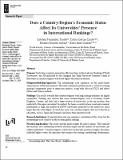Por favor, use este identificador para citar o enlazar a este item:
http://hdl.handle.net/10261/210750COMPARTIR / EXPORTAR:
 SHARE SHARE
 CORE
BASE CORE
BASE
|
|
| Visualizar otros formatos: MARC | Dublin Core | RDF | ORE | MODS | METS | DIDL | DATACITE | |

| Campo DC | Valor | Lengua/Idioma |
|---|---|---|
| dc.contributor.author | Fernandez Tuesta, Esteban | es_ES |
| dc.contributor.author | Garcia Zorita, Carlos | es_ES |
| dc.contributor.author | Romera Ayllon, Rosario | es_ES |
| dc.contributor.author | Sanz-Casado, Elías | es_ES |
| dc.date.accessioned | 2020-05-07T11:48:43Z | - |
| dc.date.available | 2020-05-07T11:48:43Z | - |
| dc.date.issued | 2019 | - |
| dc.identifier.citation | Journal of Data and Information Science 4(2): 56-78 (2019) | es_ES |
| dc.identifier.issn | 2096-157X | - |
| dc.identifier.uri | http://hdl.handle.net/10261/210750 | - |
| dc.description | Este artículo está sujeto a una licencia CC BY 4.0 | es_ES |
| dc.description.abstract | Purpose: Study how economic parameters affect positions in the Academic Ranking of World Universities' top 500 published by the Shanghai Jiao Tong University Graduate School of Education in countries/regions with listed higher education institutions. Design/methodology/approach: The methodology used capitalises on the multi-variate characteristics of the data analysed. The multi-colinearity problem posed is solved by running principal components prior to regression analysis, using both classical (OLS) and robust (Huber and Tukey) methods. Findings: Our results revealed that countries/regions with long ranking traditions are highly competitive. Findings also showed that some countries/regions such as Germany, United Kingdom, Canada, and Italy, had a larger number of universities in the top positions than predicted by the regression model. In contrast, for Japan, a country where social and economic performance is high, the number of ARWU universities projected by the model was much larger than the actual figure. In much the same vein, countries/regions that invest heavily in education, such as Japan and Denmark, had lower than expected results. Research limitations: Using data from only one ranking is a limitation of this study, but the methodology used could be useful to other global rankings. Practical implications: The results provide good insights for policy makers. They indicate the existence of a relationship between research output and the number of universities per million inhabitants. Countries/regions, which have historically prioritised higher education, exhibited highest values for indicators that compose the rankings methodology; furthermore, minimum increase in welfare indicators could exhibited significant rises in the presence of their universities on the rankings. Originality/value: This study is well defined and the result answers important questions about characteristics of countries/regions and their higher education system. | es_ES |
| dc.description.sponsorship | This research was funded by CAPES (Coordinação de Aperfeiçoamento do Ensino) grant N. BEX 8354/13-8 awarded to Esteban Fernández Tuesta. The authors thank the anonymus reviewers for their useful remarks. | es_ES |
| dc.language | eng | - |
| dc.publisher | Chinese Academy of Sciences | es_ES |
| dc.relation.isversionof | Publisher's version | es_ES |
| dc.rights | openAccess | es_ES |
| dc.subject | Academic Ranking of World Universities | es_ES |
| dc.subject | Socio-economic indicators | es_ES |
| dc.subject | Regression analysis | es_ES |
| dc.title | Does a Country/Region's Economic Status Affect Its Universities' Presence in International Rankings? | es_ES |
| dc.type | artículo | es_ES |
| dc.identifier.doi | 10.2478/jdis-2019-0009 | - |
| dc.description.peerreviewed | Peer reviewed | es_ES |
| dc.relation.publisherversion | http://dx.doi.org/10.2478/jdis-2019-0009 | es_ES |
| dc.date.updated | 2020-05-07T11:48:43Z | - |
| dc.rights.license | https://creativecommons.org/licenses/by/4.0/ | es_ES |
| dc.contributor.funder | Fundaçao Capes (Brasil) | es_ES |
| dc.relation.csic | Sí | es_ES |
| dc.contributor.orcid | Sanz-Casado, Elías [0000-0002-0188-7489] | es_ES |
| dc.contributor.orcid | Fernandez Tuesta, Esteban [0000-0002-0087-3405] | es_ES |
| dc.contributor.orcid | Garcia Zorita, Carlos [0000-0002-6860-8069] | es_ES |
| dc.contributor.orcid | Romera Ayllon, Rosario [0000-0002-6757-0580] | es_ES |
| dc.type.coar | http://purl.org/coar/resource_type/c_6501 | es_ES |
| item.fulltext | With Fulltext | - |
| item.openairecristype | http://purl.org/coar/resource_type/c_18cf | - |
| item.cerifentitytype | Publications | - |
| item.grantfulltext | open | - |
| item.openairetype | artículo | - |
| Aparece en las colecciones: | (CCHS-IFS) Artículos | |
Ficheros en este ítem:
| Fichero | Descripción | Tamaño | Formato | |
|---|---|---|---|---|
| country_regions.pdf | 1,86 MB | Adobe PDF |  Visualizar/Abrir |
CORE Recommender
SCOPUSTM
Citations
10
checked on 29-mar-2024
WEB OF SCIENCETM
Citations
10
checked on 20-feb-2024
Page view(s)
152
checked on 24-abr-2024
Download(s)
120
checked on 24-abr-2024
Google ScholarTM
Check
Altmetric
Altmetric
Este item está licenciado bajo una Licencia Creative Commons

